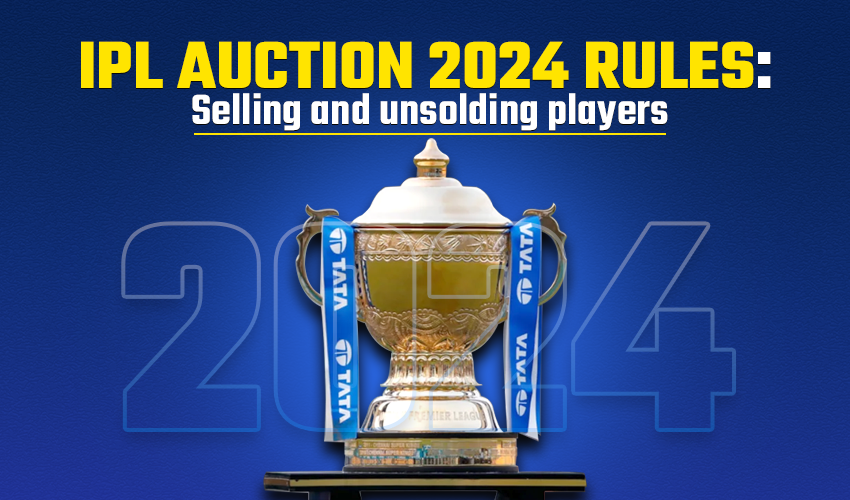
December 25, 2023
A step-by-step explanation of all the regulations and procedures that franchises, auctioneers, and players will adhere to regarding the Indian Premier League auction is presented here before the auction takes place.
It will only be a few hours until the gavel is dropped, which will signal the beginning of the Indian Premier League 2024 player auction. This is a cricketing extravaganza in which talent is the focal point and fortunes are exchanged in the blink of an eye.
The yearly dance of demand and supply is what sets the scene for the 20-20 frenzy that engulfs India. This extravaganza promises to unleash bids that shatter records and discover the next generation of cricketing superstars.
The fierce bidding battle that will take place in Dubai’s Coca-Cola Stadium will last for nearly eight hours and one minute. The players will discover new and ancient residences, which will destroy banks, the waste of money, and the formation of new relationships.
Veterans will have the opportunity to demonstrate their level of expertise on a new stage, while younger players will have the chance to make a name for themselves. Therefore, with that being stated, in preparation for the major spectacle, the following is a step-by-step breakdown of all of the regulations and procedures that players, auctioneers, and franchisees will adhere to.
Let’s get you ready for this grand event by providing you with the fundamental instructions that regulate it before the bidding frenzy takes over.
It is necessary for players to be nominated by their national cricket boards and to fulfill the eligibility requirements set out by the BCCI. As a starting point for bidding, each person determines their base price of their own accord.
Each team is allowed to have a maximum of 25 players, with certain limitations placed on the amount of players that are either Indian or from other countries. Players are called out one at a time during the main round, and franchises begin to raise their paddles to place bids.
The battle lines are established as the voice of the auctioneer spells out each name and the auction begins. The beginning points of what is going to be an exciting ascent are going to be the basic costs of the players. As the bids continue to rise in increments of ₹20 lakh, the suspense continues to unfurl until the ₹1 crore milestone is broken. After that, the stakes come into play.
Every successful offer that falls within the range of ₹1 crore to ₹2 crore causes the price to increase by ₹25 lakh. Furthermore, after the bids surpass the ₹2 crore threshold, the price increases by ₹50 lakh with each rise of the gavel. Who will the record be broken by? Who is the emerging talent that will cause a bidding frenzy that will push the boundaries of prior benchmarks? As far as the past is concerned, there is a great deal.
Certain players can join teams more quickly than others because of a specialized lane that is available. The names of initial players includies all capped and uncapped lists are shouted out during the first few sets of this one-of-a-kind procedure, which takes place throughout the first few matches.
Additional bidding rounds may take place, to explicitly target players who have not been sold, if spots continue to be unfilled and clubs discover that they have funds left over. Because of this, the Indian Premier League player auction is a show-stopping event because of its deliberate pauses and rushed rounds.
Even if a player is unfortunate enough to lose out on the first rush of bidding, there is still a chance for them to win. In the aftermath of the end of the expedited round, clubs who are still in possession of open slots and financial flexibility are entitled to submit updated lists that emphasize players who have not yet been sold.
It is at this phase that hidden talents, who were first neglected in the excitement of the opening bids, get the opportunity to find their true homes. This phase provides a platform for redemption.
In this list we have Chris Gayle, by Punjab Kings, he was selected at the 11th hour, who was then known as Kings XI Punjab, during the auction of 2018. He went on to score 368 runs, and while it wasn’t the finest of seasons for The Universe Boss, he did best to the Indian Premier League the next year with a total of 490 runs.
Read Also: Where and How to Play Cricket Betting Online
The ‘Right to Match’ card, which caused controversy in the first few seasons, is gone. A team bought an unretained cricketer from the last Indian Premier League (IPL) auction for the top price. RTM cards were introduced before the 2018 IPL auction but were discontinued before the 2022 super auction. RTM card supply was halted since retention was increased from three to five.
Players selected for the Indian Premier League Auction 2024 are grouped into 19 sets by strength. These include batters, all-rounders, fast bowlers, spinners, and wicket keepers. After many sets, the sequencing will swap between cap-wearing and cap-less players.
Choose from 23 players in the highest price bracket, limited to ₹2 crore. Which includes Indian players Harshal Patel, Shardul Thakur, and Umesh Yadav. The price range is ₹75 lakhs, ₹40 lakhs,₹50 lakhs, ₹30 lakhs, and ₹20 lakhs, ₹1.5 crore, ₹1 crore etc.